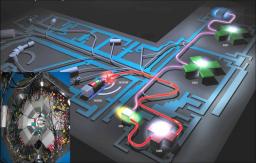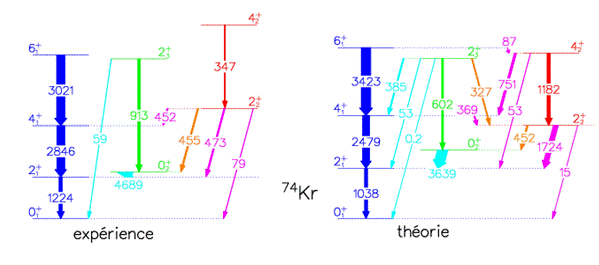The shape of an atomic nucleus reflects the shell structure of the protons and neutrons of which it is formed. If the shells are completely filled, we speak of a "magic" nucleus, which is spherical in shape. Most nuclei, however, tend to be deformed because their shells are only partially filled. The most commonly encountered shapes are elongated (prolate) or flattened (oblate); these shapes can change from on nucleus to its neighbour by adding or removing a proton or neutron. In some cases it is sufficient to rearrange the protons or neutrons within the same nucleus to change its shape. The same nucleus can therefore assume different shapes corresponding to states of different energy. If such states come close in energy (one thousandth of the binding energy of the nucleus or so), the different shapes can mix. According to the laws of quantum mechanics, the nucleus can coexist in different shapes (e.g. elongated and flattened) at the same time. Such shape coexistence was observed in light krypton and selenium isotopes in a series of experiments performed by a team of researchers from the Nuclear Physics Department (SPhN) of IRFU .
How can we measure the shape of a nucleus? When a deformed nucleus is excited to rotate or vibrate, it returns to its equilibrium state by emitting electromagnetic radiation which is characteristic for its shape. Such excitations occur when a nucleus passes a target nucleus at a small distance of a few femtometers (10-15 m), and at high velocity of about 10% of the speed of light. This method of Coulomb excitation has been used only with stable isotopes in the past, and was now for the first time extended to study the shape of radioactive krypton-74 and -76 isotopes (denoted 74Kr and 76Kr). Beams of these isotopes, produced and accelerated by the SPIRAL facility at GANIL, were impinging on a lead target (see Figure 1). The analysis of the gamma rays emitted from the excited states of 74Kr and 76Kr, which were measured using the EXOGAM spectrometer, has shown the prolate character of the ground states in both isotopes [1]. In both cases there are unusually long-lived states at low excitation energy which correspond to oblate shape; these are called shape isomers. The above result represents the first direct measurement of the shape of a radioactive nucleus. The study of 72Kr and its shape isomer shows that the situation is reversed for this isotope: the ground state has oblate shape in 72Kr [2]. However, the shapes are not pure in character, as they can mix together! All the results obtained allows a quantitative analysis of the mixing between prolate and oblate shapes for the various states. It is found that the shapes are more strongly mixed in 74Kr than in the neighbouring isotopes [2,3].

Figure 1. Experimental set-up used at GANIL (the large-scale, heavy-ion accelerator in Caen, France). A primary beam of 78Kr (pink), stable isotope of krypton, is accelerated subsequently by the accelerators CSS1 and CSS2. Radioactive 74Kr or 76Kr nuclei are produced in fragmentation reactions from 78Kr using the Spiral on-line isotope separation facility. The 74Kr and 76Kr isotopes (red) are then accelerated by the third cyclotron, CIME, and directed onto a 208Pb target located at the centre of the EXOGAM spectrometer (inset photo).

Figure 2. Comparison of experimental (left) and theoretical results (right) for 74Kr. The level schemes show prolate (blue) and oblate (green) rotational states as well as vibrational states (red). The numbers and the widths of the arrows indicate the transition probabilities. Transitions connecting different types of states are shown in the corresponding mixed colours. Given the complexity of the level scheme, the agreement between theory and experiment is remarkable. Similar agreement was found for Kr-76.
The comparison of these experimental results with theoretical calculations represents a stringent test of nuclear structure models. This work was carried out in collaboration with a team of theoreticians from CEA DIF/DPTA, who have developed a theoretical model to calculate the "configuration mixing". The agreement between experiment and theory is excellent, allowing the classification of the various states according to their shape (Figure 2). The calculations confirm a strong mixing between prolate and oblate states, but they also show that the situation is more complex: triaxial deformation (neither purely prolate nor purely oblate) is needed to obtain an exact description of shape coexistence in the krypton nuclei.
A similar competition between prolate and oblate deformation is expected in the light isotopes of selenium. Most theoretical models predict an oblate ground-state deformation in 68Se and 70Se. However, a recent Coulomb excitation measurement carried out at CERN, in combination with an earlier measurement of the lifetime of the first excited state of 70Se, reveals a prolate deformation for this state, which contradicts the above scenario. In order to verify this surprising result, the team from SPhN has performed a new and more precise lifetime measurement for 70Se and 72Se in Legnaro, Italy. (Legnaro is a European Associate Laboratory of GANIL). The excited selenium nuclei were stopped in a gold foil at a variable distance (of a few micrometers) after the target. The gamma rays emitted by the 70Se nucleus during its flight (before stopping in the target) are shifted in energy due to the Doppler effect. These gamma rays correspond to short lifetimes (less than the time of flight defined by the target-stopper distance). The gamma rays emitted by nuclei at rest in the gold stopper foil are not Doppler-shifted and correspond to longer lifetimes. Lifetimes of a few picoseconds (10-12 s) can be extracted with high accuracy from the intensity ratio of the shifted and unshifted components as a function of the distance. The results show that the previous lifetime measurement was incorrect and that 70Se has an oblate ground-state shape [4]. Once again, the agreement with the configuration mixing calculations is very good.
This experimental and theoretical work provides us with an overall understanding of shape coexistence and the evolution of shapes in the light selenium and krypton nuclei.
Contact :
To go further:
Interview: Andreas Goergen (Windows Media Player)
Références :
[1] E. Clément et al., Phys. Rev. C 75, 054313 (2007)
[2] E. Bouchez et al., Phys. Rev. Lett. 90, 082502 (2003)
[3] A. Görgen et al., Eur. Phys. J. A 26, 153 (2005)
[4] J. Ljungvall et al., Phys. Rev. Lett. 100, 102502 (2008)



